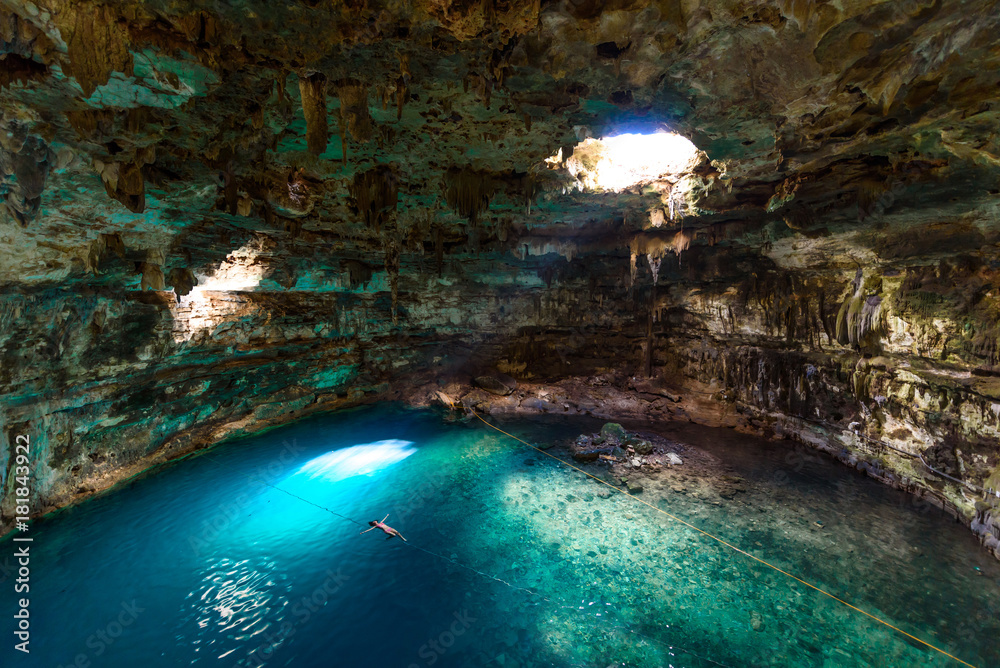Discovering the Enigmatic Beauty of Cenotes: Mexico’s Hidden Natural Wonders
In the heart of Mexico’s lush landscapes lies a hidden world of awe-inspiring beauty and mystery: cenotes. These natural sinkholes, formed over thousands of years, hold both cultural significance and ecological importance. From their enchanting crystal-clear waters to the intriguing history they hold, cenotes offer a captivating exploration into the depths of Mexico’s natural wonders.
The Formation of Cenotes: Nature’s Subterranean Marvels
Cenotes are geological formations unique to the Yucatán Peninsula in Mexico, particularly in the state of Quintana Roo. They are a result of the region’s distinctive limestone terrain, where the ground is permeated with underground rivers and caves. Over time, the collapse of cave ceilings or the erosion of soft limestone created these mesmerizing sinkholes, revealing the pristine turquoise waters below. The name “cenote” originates from the Mayan word “dzonot,” meaning “well.”
This remarkable landscape is further connected to the Chicxulub Crater, an impact crater also situated on the Yucatán Peninsula. Around 66 million years ago, an asteroid or comet struck the Earth, creating the massive Chicxulub Crater. While not directly responsible for cenote formation, the impact played a role in shaping the region’s geology, making it particularly conducive to the creation of cenotes. The limestone bedrock, affected by the impact, interacted with rainwater over millennia, resulting in the intricate network of underground chambers that define cenotes.
Cultural and Historical Significance
For ancient civilizations like the Mayans, cenotes were more than just geological formations – they held deep spiritual significance. Cenotes were considered sacred portals to the underworld, believed to be inhabited by powerful deities. These natural pools were used for ceremonial offerings, as well as water sources for communities. The legendary city of Chichen Itza, for example, relied on the Sacred Cenote for both rituals and sustenance.
Ecological Importance and Biodiversity
Beyond their cultural significance, cenotes play a crucial role in the region’s ecology. They serve as unique ecosystems, hosting a variety of flora and fauna, some of which are found only in cenotes. These underwater habitats have evolved independently, resulting in the adaptation of several species to the cenote environment. Some cenotes also provide vital freshwater sources for local wildlife.
Diving into Cenote Exploration
Today, cenotes have become a magnet for adventure seekers and nature enthusiasts. Exploring these natural pools offers an opportunity to connect with nature’s beauty while unraveling the mysteries of the past. Snorkeling and diving in cenotes reveal intricate rock formations, shimmering stalactites, and mesmerizing underwater passages. The clarity of the water creates a surreal experience, allowing divers to feel like they’re floating in a crystalline universe.
Notable Cenotes to Explore
- Ik Kil Cenote: Located near Chichen Itza, Ik Kil is a renowned cenote known for its majestic opening and lush vegetation surrounding its rim. Its deep blue waters beckon visitors for a refreshing swim.
- Dos Ojos Cenote: This complex of cenotes is famous for its underwater cave systems. Divers can explore interconnected passageways adorned with stunning rock formations.
- Gran Cenote: Set in the Tulum region, Gran Cenote is a natural marvel with clear waters and intriguing underwater formations, making it a haven for snorkelers and divers alike.
- Cenote X’keken: Also known as Cenote Dzitnup, X’keken offers a unique experience with its underground pool surrounded by stalactites and vines, creating an otherworldly atmosphere.
- Cenote Samula: Adjacent to Cenote X’keken, Samula enchants visitors with its stunning sunbeam illuminations and serene waters.
Preserving the Cenote Ecosystem
As these natural wonders gain popularity, it’s essential to practice responsible tourism to protect the delicate cenote ecosystems. Visitors are encouraged to use biodegradable sunscreens, avoid disturbing wildlife, and follow guidelines set by local authorities.
In essence, cenotes are not just geological formations; they are gateways to history, culture, and nature’s most captivating realms. From their mystique-filled origins to their thriving ecosystems, cenotes beckon travelers to embark on a journey of exploration, reflection, and wonder, uncovering the timeless beauty that lies beneath the surface.
OpenAI. (2023). Cenotes. Reviewed and edited by VivMo Projects, LLC.
